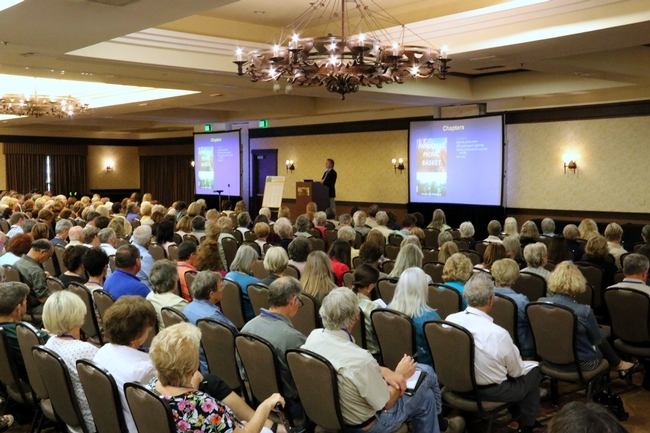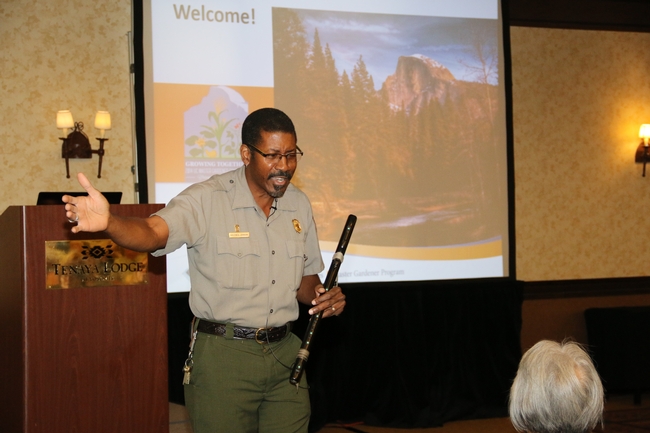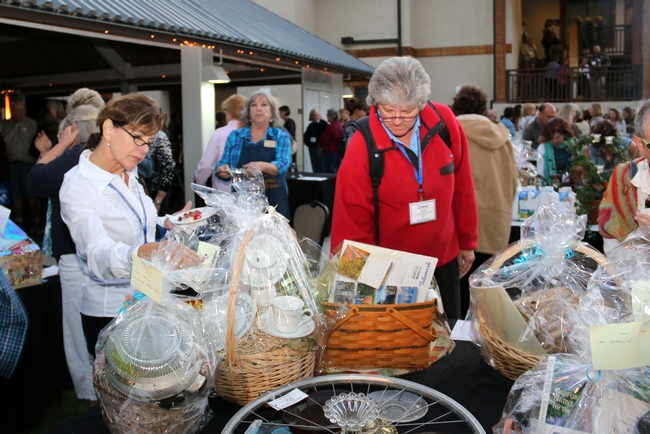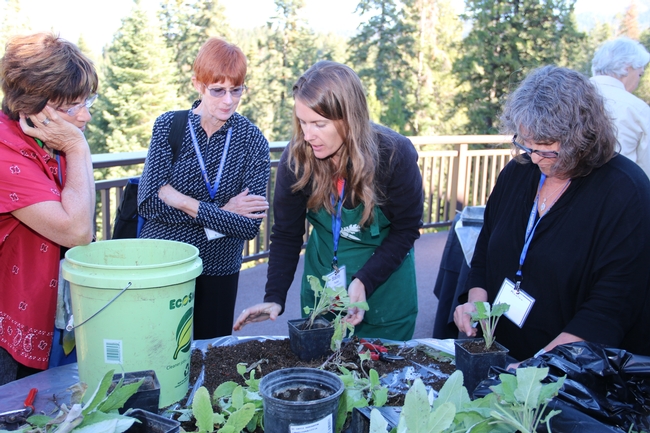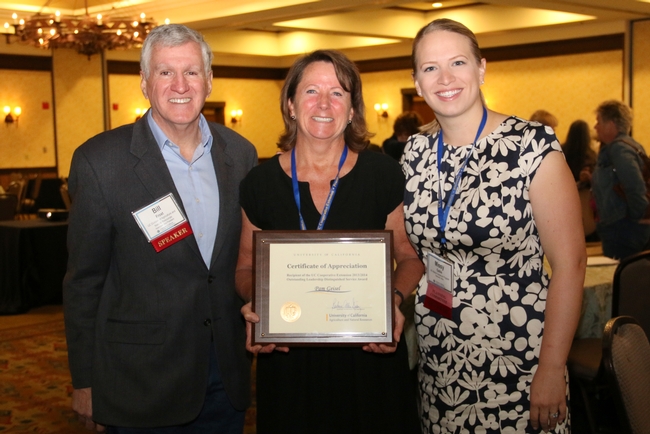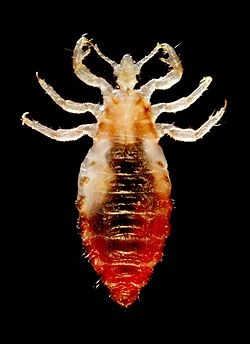From the UC Blogosphere...
Going Native
Going Native During a Drought By Steve McDermott UCCE Master Gardener Many of my plants have...
Daily Life For Master Gardeners
The Fiesty Widow By Andrea Peck The western black widow spider—a native species—is widespread and is...
Marvels of Migration
Lately we've been fascinated by the migrating Monarch butterflies (Danaus plexippus) heading to coastal California and...
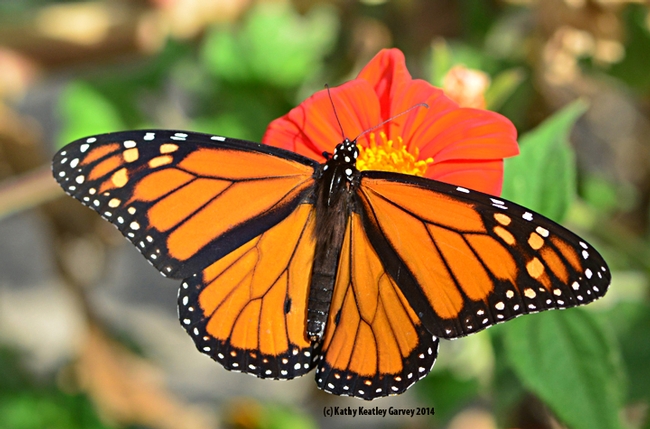
A mighty male Monarch on the move. On its way to one of coastal California's overwintering sites, it stops to sip from flight fuel (nectar) from a Mexican sunflower, Tithonia. (Photo by Kathy Keatley Garvey)
UC Master Gardeners from Across California “Growing Together” at 2014 Conference
With more than 650 participants, including 48 break-out sessions and four keynote speakers there was a wealth of knowledge and experience available to all that attended the triennial 2014 UC Master Gardener Conference.
Welcome & keynotes
Two keynote speakers followed Johnson's inspirational welcome, Doug Tallamy a professor in Entomology and Wildlife Ecology at the University of Delaware, and Alan McHughen a public sector educator, scientist and consumer advocate for UC Riverside. Tallamy, author of “Bringing Nature Home”, presented the importance of biodiversity in our ecosystems.
“Replacing half of the area that is now barren lawns with plants that are best at supporting food webs would create over 20 million acres of connectivity [nationally] and go a long way sustaining biodiversity in the future,” encourages Tallamy.
The opening day's final keynote speaker, Alan McHughen, presented on what every UC Master Gardener should know about genetically modified organisms (GMOs). His presentation was focused around his research findings, published in “Pandora's Picnic Basket”. McHughen explained the basics of rDNA technology and how it is used in agriculture and horticulture.
A magical night at Tenaya
The silent auction was a huge success with many counties donating beautiful baskets of local goods and handmade items. The total raised from the silent auction was more than $6,400! All of the money raised will go to offset the cost of registration for the 2017 conference.
Of the $6,400 raised, $600 was set aside for need-based scholarships. We're happy to announce the statewide UC Master Gardener Program and UC ANR are matching the $600, bringing the total up to an impressive $1800 to support need-based scholarships in 2017.
Sessions, sessions, and more sessions!
Day two of the conference was dedicated to track sessions. With six breakout rooms and eight different session times there were 48 potential topics for UC Master Gardeners to absorb. Activities ranged from a hands-on propagation workshop and gardening during a drought to UC Master Food Preserver presentations. The array of options for conference participants made 2014 the most diverse UC Master Gardener event to date.
Visit the conference website to download some of this year's most memorable presentations. Many generous speakers have offered to share their presentations for future reference with conference attendees, visit the conference website to view the uploaded presentations.
Following a full day of learning, attendees were invited to join together in the grand ballroom for dinner. Renee Shepherd, owner of Renee's Garden, joined UC Master Gardeners for dinner as the night's keynote speaker. Shepherd discussed her pioneering career in the seed business as well as future trends in the gardening industry. She also explained the differences between heirlooms, hybrids and open pollinated seed varieties during her presentation titled, “A Seedy Business”.
Search for Excellence Winners and Honoring Pam Geisel
Following the winning Search for Excellence presentations was attendees enjoyed a heart-warming celebration of gratitude for Pam Geisel, honoring her years of service to the UC Master Gardener Program. Geisel began her career with Cooperative Extension in 1981 as an environmental horticulture advisor. In 2006, Geisel became the first statewide director of the UC Master Gardener Program, helping to establish the program under the UC Division of Agriculture and Natural Resources (ANR) and doubling program reach before her retirement in 2013. UC ANR's Associate Vice President, Bill Frost, was at the conference to recognize Geisel for her contributions to the program and awarded her with the 2014 ANR Distinguished Service award for Outstanding Leadership.
The conference's final keynote presenter, Dan Heims of Terra Nova Nurseries, delivered a presentation on “Humor from the Horticultural Trenches” with many outrageous remarks and requests from the perspective of a garden clerk. Before attendees got on the road to travel home, a generous donation of plants from Monrovia were awarded to some lucky attendees.
See you in Southern California in 2017
Many thanks to the numerous volunteer, host counties and conference planning committee members who made the 2014 conference a reality. Without their dedication and support the conference would not have been possible. We look forward to reaping the harvest of our success in growing together at the 2017 UC Master Gardener Conference in Southern California.
Do you have a suggestion for the next conference or feedback for this year's event? Let us know at ucanr.edu/mgfeedback.
Really Lousy Information!!!
Help for the Home Gardener from the Contra Costa Master Gardener Help Desk
Client's Problem:
CCMG Help Desk Analysis:
Under the office microscope we saw a mostly transparent, approximately 5mm insect with 6 legs with pincer ends. Legs and head were not moving. The center of the body had a sac of constantly moving dark red fluid (later identified as the client's blood). Review of our source material and confirmation with our entomologist identified the insect to be a body louse (Pediculus humanus humanus).
CCMG Help Desk Response to Client:
Well, we have some good news and some bad news. The good news is we identified the insect that has been biting you; the bad news is that it is body lice. The specimen you bought in is a body louse (Pediculus humanus humanus). Lice are very small flat bodied wingless insects (adults are 2-4mm long) that live exclusively off blood. Human body, head and pubic lice are also exclusively human parasites and cannot feed on any other animal. These insects are wingless and have legs adapted for crawling through hair or on clothing.
Although closely related to the head louse (quite common in elementary schools), the body louse differs in a number of significant ways:
- Body lice lay their eggs in clothing, cementing them to fibers.
- Adult and immature lice will shelter in the seams and folds of clothing worn for long periods, moving on to the host only to feed.
- The life cycle is 9 - 10 days from egg to adult, unless clothing is removed at night. Then complete development may take 2 - 4 weeks.
- These lice will die if clothing is not worn for several days.
- Body lice must feed every 24 hours, and if they cannot do so will quickly starve to death.
Body lice are spread through direct physical contact with a person who has body lice or through contact with articles such as clothing, beds, bed linens, or towels that have been in contact with an infested person. Body lice are usually only found in indigent people and particularly the homeless.
As far as treatment goes, you can check with your doctor, now that you know what's biting you. The doctor may have a prescription medication. For sure, all your clothing, bedding, and towels should be laundered using very hot water (at least 130°F) and machine dried using the hot cycle.
I am including several links that have additional information below:
http://www.cdc.gov/parasites/lice/body/index.html
http://www.calsurv.org/node/73
I hope this information helps you. This has obviously been quite a long and drawn out ordeal for you! Please let us know if you have any further questions.
Contra Costa Master Gardeners Help Desk
Editor's Note: The Contra Costa Master Gardener Help Desk is available year-round to answer your gardening questions. Except for a few holidays, we're open every week, Monday through Thursday from 9:00 am to Noon at 75 Santa Barbara Road, 2d Floor, Pleasant Hill, CA 94523.
We can also be reached via telephone: (925) 646-6586, email: ccmg@ucanr.edu, and we are on the web at http://ccmg.ucanr.edu/



